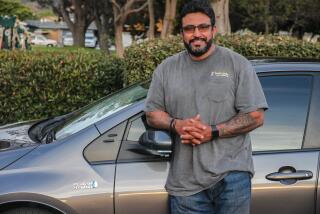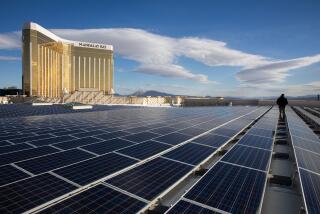160-Mile Race Gives Solar Cars Place in the Sun
- Share via
VISALIA, Calif. — MIT senior James Worden drove his flat-top, solar-paneled Solectria V to victory in this country’s first solar car race, taking three hours and five minutes to complete the 160-mile American Solar Cup course along freeways and country roads in Tulare County.
The quiet, pollution-free solar car race was a highlight of the 14th annual International Human Power Vehicle Speed Championships held here this weekend. More than 100 competing Rube Goldberg-like human-powered vehicles from several states, Canada and West Germany came for the three days of competition.
Only two of the 10 solar cars in the United States competed in the solar car race, Worden’s Solectria V and the Mana La, an arch-shaped vehicle with a missile-like nose from Paauilo, Hawaii.
Studies Engineering
Worden, 21, called the Henry Ford of solar cars, has designed and built six of the 10 working sun-powered automobiles in the country. The mechanical engineering student was the first American ever to race in a solar car race, the Tour De Sol in Switzerland.
The only other country holding a solar car race has been Australia, which staged a 500-mile outback solar car race last June.
The Mana La, bearing the Hawaiian license plate SUN 32, broke down three times in the American Solar Cup, completing 102 miles in 5 1/2 hours when it was finally towed away.
Sponsored by the Paul Mitchell Salon Systems of Beverly Hills, the Mana La was driven on the first lap by Jonathan Tennyson, 43, the car’s designer, and on the second lap by John Paul Jones de Joria, 54, the company’s chairman of the board.
Worden’s solar car team at the Massachusetts Institute of Technology is sponsored in part by Dow Chemical Co.’s Automotive Materials Group and de Joria. Both announced plans for mass production within three years.
“I plan to . . . produce a computer solar car that will sell for about $3,000,” Worden said. “It will be a second car to go to and from work, to go shopping, with the regular car available for long trips.”
The MIT student built his first solar-powered commuter car when he was 16.
De Joria said he plans to produce full-size family solar cars that will sell for under $10,000. He operates three solar farms in Hawaii where “everything is powered by sunshine, from the lawn mowers to pickup trucks.”
California Highway Patrolman Don Gibson, 50, whose patrol car escorted the MIT entry on the 160-mile course, likened the solar car creators to the Wright Brothers.
“James Worden’s car performed beautifully, as well as anything, if not better, on the freeways and up and down the winding hills in the back country,” Gibson said. The MIT car has a maximum speed of 90 m.p.h.
This year’s two-car race “is a forerunner to a major cross-country solar car race next year in the United States that will attract several entries from Australia, Germany, Switzerland and this country,” said Robert Cotter, 32, the American Solar Cup director from Waldoboro, Me.
For three days, this Central California town was host to more than 300 of the 1,600 members of the International Human Power Vehicle Assn., who put their peculiar- appearing but practical pedaled vehicles through time trials, slaloms and hourlong races.
The vehicles are converted conventional bicycles covered with a plastic or fabric shell and constructed so that the driver is in a more comfortable reclining position.
Called Car of the Future
The resulting contraptions take on bizarre narrow configurations, some looking like fish on wheels, torpedoes or windshields moving rapidly along a street.
Similar to the proponents of solar cars, human-powered vehicle enthusiasts see their pedaled vehicles as substitutes for automobiles in the future, the answer to a quieter, smog-free world.
The aerodynamic improvement of such vehicles makes for a faster form of cycling by smoothing the air flow and reducing wind resistance by as much as 80%.
World-class bicycle racers riding the finest bikes can obtain top speeds of about 40 m.p.h. compared to 65.8 m.p.h., the world record by a human-powered vehicle set by Fred Markham, 41, of Freedom, Calif., at Mono Lake in 1986.
And, true to form, at the weekend get together in Visalia, Markham rode off with the best time, 55.51 m.p.h. in the 200-meter sprint. In the hourlong competition he completed 34 laps, more laps than anyone else.






